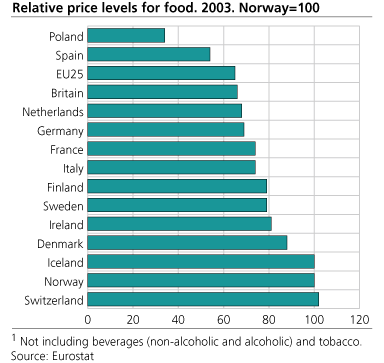Content
Published:
This is an archived release.
High food prices in Nordic countries
Together with Iceland and Switzerland, Norway has the highest food prices in Europe. Denmark, the EU member country with the highest prices of food, is 12 per cent below the Norwegian level, whereas the corresponding figure for Finland and Sweden is 21 per cent. The latter two are still clearly above the average price level of the 25 EU member countries (EU25) seen as a whole, and of countries like Britain and Germany.
The price level of non-alcoholic beverages is somewhat higher in Denmark than in Norway, whereas the Norwegian price level is the highest in Europe as far as alcoholic beverages and tobacco are concerned.
Highest price level in the EFTA countries
Considering food only, Iceland, Norway and Switzerland stand out with an exceptionally high price level of more than 50 per cent above the EU25 average. This can possibly be interpreted in the light of these countries' non-participation in the European Common Agricultural Policy, a fact that affects domestic competition. In addition, all three countries have a high level of income, a characteristic often correlated with high price levels.
Considerable intra-EU differences
This does not imply that there is a uniform price level in the EU seen as a whole. Among EU countries, Denmark stand out with a high relative price level, ahead of Ireland, Finland and Sweden, which are all at about the same level. In many of the new member countries, like Poland, the price level is just above half the EU average, or about one-third of the Norwegian level. If we look at just the 15 'old' member countries, the price level varies between 54 per cent of the Norwegian level in Spain to 88 per cent in Denmark.
Norway: High price levels for meat, sugar and cereals
Even though the price level in Norway is higher than the European average for all groups of food products, there are considerable differences between those sub-groups. Meat in particular, but also sugar products (including e.g. jams, chocolates, and confectionary), bread and cereals all have a high relative price level in Norway. On the other hand, fish and highly processed foods like baby food, spices, sauces and soups ('food products n.e.c.') are sub-groups with a price level more in line with the rest of Europe.
Norway also comes out on top when we consider the relative price level of alcoholic beverages and tobacco, which are highly taxed. In the case of non-alcoholic beverages, Denmark comes out slightly ahead of Norway. The two countries stand out especially with regard to mineral waters, soft drinks, and fruit and vegetable juices. For coffee, tea and cocoa, price levels are more uniform between countries.
Not a 'standard-of-living' indicator
The figures presented here are based on price data collected in the 31 countries that take part in the European Comparison Programme during a survey in Spring 2003. The price material has later been adjusted to annual average prices and weighted with expenditure values from each country's National Accounts.
The relative price level of a given country thus is not an indicator of that country's material standard of living, but rather expresses the price level consumers are facing if they conform to the average consumption pattern of that particular country.
Read more about this topic in Eurostat's " Statistics in Focus "
Tables:
The statistics is now published as Comparison of price levels in Europe.
Contact
-
Statistics Norway's Information Centre
E-mail: informasjon@ssb.no
tel.: (+47) 21 09 46 42

